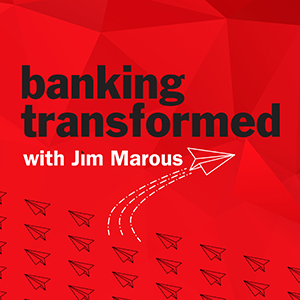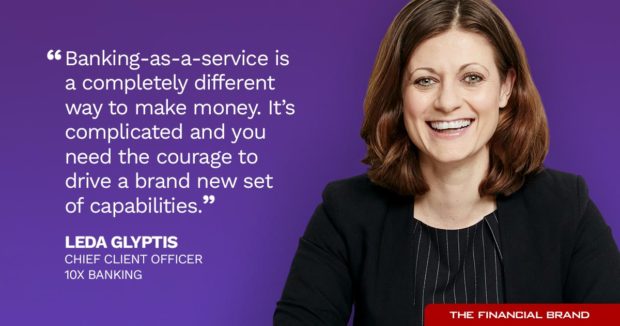It’s a given that banks and credit unions will embark on a digital transformation journey. But not every institution will arrive at the destination they expected.
Digital transformation efforts at some institutions do reap significant rewards in customer retention, cost reductions and, most importantly, positioning the organization for a digital future.
Other institutions seem lost, stumbling around and implementing digital initiatives seemingly without purpose. Still others have a good handle on technology but are taken aback when they realize they have no control over rapid economic disruptions that impact their business.
That’s because implementing technology is only one piece of successful digital transformation. Bankers also need to prioritize what’s most impactful, combine new technology with legacy values and experiences, leverage partnerships and embrace a challenger mindset.
Jim Marous, Co-Publisher of The Financial Brand and CEO of the Digital Banking Report spoke with Dr. Leda Glyptis, Chief Client Officer at 10X Banking for the Banking Transformed Podcast. They discussed why banks and credit unions often lose their way on their digital transformation journey and what they should do to stop sabotaging their hard work.
Glyptis is a former banker, technology executive and Founding CEO of 11:FS Foundry. She joined 10X Banking in 2020. The company created and offers banks a cloud-native core banking platform. In the podcast Glyptis identifies seven factors that will help financial institutions succeed at true digital transformation.

The Power of Localized Marketing in Financial Services
Learn how to enhance your brand’s local visibility, generate more leads, and attract more customers, all while adhering to industry regulations and compliance.
Read More about The Power of Localized Marketing in Financial Services

Move the Needle from Attrition to Acquisition
Vericast’s 2024 Financial TrendWatch explores seven of today’s most critical financial services trends to provide a complete view of the current loyalty landscape.
Read More about Move the Needle from Attrition to Acquisition
1. Shed Bad Habits
Because legacy financial institutions and their infrastructures are so complex, digital transformation costs a lot of money and requires a lot of human capital and creativity.
Unfortunately, bankers bring a lot of baggage to digital transformation that makes it challenging to achieve their objectives. One is a culture that rewards action, not results.
“Banking has a culture of busyness where everyone’s day is chopped up into half hour increments that add up to a 14 hour day,” explains Glyptis. “The culture is not designed for creativity or for tackling big questions. Instead, the culture decimates your attention span and your patience.”
The Culprits:
Technology is rarely the stumbling block for digital transformation. More often, it’s organizational, cultural and mindset issues that doom transformation efforts.
Marous agrees that traditional banking culture is not compatible with innovation. “Bankers are trying to do what they do faster or add things to the mix, but they really need to rethink banking from the core,” explains Marous. “Taking everything that your institution does today and moving it to the cloud does not make your institution better.”
Read More: Engaging Employees to Accelerate Digital Banking Transformation
2. Get Motivated to Change
“Very bluntly, our industry is hindered by legacy banking leadership,” says Marous. Bankers are victims of their own success since success does not create the motivation to change. “When nothing seems broken, it’s difficult to see how broken things really are,” notes Marous, adding, “Just because you have accounts doesn’t mean that you aren’t losing the relationship to companies outside the traditional banking industry.”
Bankers tend to suffer from “boiling frog syndrome” and don’t recognize the severity of disruption until it’s too late. “Banks have to realize that fintechs are not going to take them on head on, but will bite away at their value chain piece by piece. To combat that, you need to venture forth like a leader should,” says Glyptis.
3. Understand Platform Economics
Glyptis believes that platformification and banking-as-a-service (BaaS) are related trends that will disrupt the industry the most. Everyone is talking about these new business models but unfortunately, the majority of bankers don’t understand platform economics and how BaaS will fundamentally change financial institutions’ relationships with consumers.
“The combination of open finance plus API, messaging and data standardization puts the consumer in control and pushes banks further away,” warns Glyptis. “Consumers may not even know what bank they are dealing with.”
Winning at BaaS is all about leadership, not technology, she adds. “To do BaaS and [have it] coexist alongside your traditional bank, you must understand the economics. This is a completely different way to make money. It’s complicated and you need the courage to drive a brand new set of capabilities.”
Not to mention that there won’t be room for everyone who wants to join the BaaS train. “We have too many banks and the world doesn’t need that many platforms,” says Glyptis. “Platform banking is not going to be a monopoly, but it’s definitely going to be an oligopoly.”
Read More: Lessons from a Bank Chief Transformation Officer
4. Assume You’re Wrong
By now most bankers have heard the term “fast fail.” But it’s human nature to keep plugging away at something, even if it doesn’t appear to be working. And bankers are no exception.
Instead, get out before it’s too late. Says Glyptis, “A lot of people defend a mistake because they’ve spent a lot of time making it. You waste valuable time trying to believe or persuade yourself that you are right when you’re not.”
She offers this advice instead: Anticipate that it’s entirely possible that you are wrong and plan accordingly.
Another mistake that bankers often make is that they think they are innovating when they aren’t. Often, they try to align innovation with the bottom line, but innovation is less about revenue and more about experimentation. And finally, bankers tend to aim for perfection. “When you overthink a process, you fall further and further behind. Perfection works against innovation,” says Marous.

5. Make Banking Exciting to Attract Talent
As banks and credit unions move from legacy systems to the cloud and other newer technology platforms, they need employees with new skill sets. But these employees don’t want to work in banking. They’d rather work in what they consider more exciting or impactful industries like fintech or gaming. Let’s face it: Banking isn’t the hottest prospect for those with marketable and in-demand technology skills.
To attract talent, shift the job description to make it more enticing, suggests Glyptis. Emphasize that employees will work on solving one of the biggest problems humanity is facing or will help build systems that can scale to serve five billion customers at low cost and increase financial inclusion.
Of course, to retain these employees, you have to deliver on that vision. You also must treat them with respect and not like just a cog in a wheel, says Glyptis.
Read More:
- 6 Digital Banking Transformation Trends for 2022
- 5 Ways Citizens Bank is Turbocharging Its Digital Transformation
- How to Build a Data Culture that Supports Digital Banking Transformation
6. Move Transformation Out of the Shadows
Digital transformation traditionally takes place in a dedicated business unit or department responsible for specific projects but digital transformation in a bubble doesn’t work, not because employees aren’t doing good work, but they may be “chasing their tail,” warns Glyptis.
Instead, involve the entire institution by asking a deceptively simple question: Why am I doing this? How do these transformation initiatives help my institution operate and remain viable in the fully digital economy?
Digital transformation isn’t about what you’re going to do next but hitting the brakes and recognizing that in a digital economy, having five different systems that don’t talk to each other is a serious problem.
“It’s not about bringing your legacy environment into the future, but about defining what you want to become,” explains Glyptis.
7. Build an Emotional Brand
Disney. Apple. Nike. Consumers are willing to pay a premium for these brands because they have an emotional connection to them. Banks and credit unions can also create brand awareness and connection that goes beyond transactions and is based on emotion, believes Marous.
The key, says Glyptis, is to focus on providing service to consumers. “Either be of service or get out of the way. If your purpose is to be of service, you will create an emotional connection,” says Glyptis, adding that there’s a huge opportunity for financial institutions to be both purposeful and profitable at the same time.









